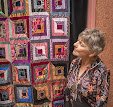
Jonathan Holstein considered pieced quilts superior to appliqué quilts in variety, invention and ingenuity. "For the quilt maker, the pieced block dictated the use of basic geometric forms, the possibilities of which were later sensed and exploited by abstract painters. The beauty of appliqué quilts is more of a decorative nature than that seen in the best of the pieced quilt, which when successful are the results of legitimate questions having been posed and most convincingly resolved. The license to draw freely, if it is encumbered with considerations of what is "elegant" or in "good taste", maybe more confining than finding creative solutions within a given format."Despite the fact that the period when many of these quilts were made, i.e. the mid-19th to the early 20th century, saw the emergence of geometric form as a consciously employed primary source in design, painting and sculpture, Jonathan Holstein reminds us that when such quilts were made they were accepted as common, utilitarian objects, not "art"; indeed, if presented as such they would certainly have been reviled. Nonetheless,,comparison between the visual effects of some of the best 19th and early 20th century quilts and paintings of that period are irresistible. Holstein points out the similarities between the "total visual effects " of some pieced quilts and examples of modern painting, for instance the retinal stimulation achieved through colour and formal relationships, and optical illusion, in the works of artists such as Vasaraly, while the use of repeated images drawn from the environment reminds us of the sequential use of images exemplified in the work of Andy Warhol. Colour variation on a single format, as seen in some Amish quilts, is compared with, for example, Josef Albers’ Homage to the Square series.There are other points of comparison between quilts and paintings: quilts have the same format as most paintings, that is to say they are rectangular or square. (Painters fitted their frescoes largely to squared interiors and exteriors, worked on squared panels, used rectangular structures, whereas the square or rectangular format of the quilt was the fitted by the size and shape of beds.) Finally, quilts like paintings are two dimensional.Holstein goes on to say: "intriguing and startling as the resemblances me be, any direct linking of the two media [i.e. quilting and painting] would be demeaning to the history and presence of both quilts and paintings. Implicit in the art of creating painting is the intellectual process which ties the work of an artist to his disaffected ancestors and his peers, and places sit in the history of objects specifically made to be art. This is precisely the quality which was absent in the making of pieced quilts. The women who made pieced quilts were not "artists", that is, they did not intend to make art, had no sense of the place of their work in a continuous stream of art history, did not, in short, intellectualise the production of handcraft any more than did the makers of objects in the vernacular tradition the world over." Jonathan Holstein: The Pieced Quilt. An American Design Tradition.
Illustration shows 'Alhambra I', the first in a series of quilts inspired by Moorish decorative motifs.

No comments:
Post a Comment